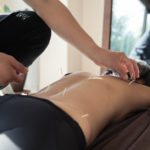Yoga For Back Pain?
Is it true that yoga or physical therapy can reduce back pain and also help affected people overcome sleep problems? I’m desperate for a solution.
Andrew Weil, M.D. | November 27, 2019

I have long recommended yoga as means of relieving back pain. I am happy to tell you that recent research has confirmed that both yoga and physical therapy can ease back pain and help affected people sleep. A study from Boston Medical Center (BMC) published in October 2019 found that 12 weeks of yoga classes or one-on-one physical therapy reduced back pain among the 320 adults participating and improved the quality of sleep in those who complained of sleeping problems. The researchers reported that the patients whose pain improved after six weeks of treatment were three and a half times more likely to report improvements in their sleep after 12 weeks. Encouragingly, the study showed that the improvements in sleep quality lasted 52 weeks.
The researchers noted that sleep disturbance and insomnia are common among people with chronic low back pain and cited earlier research showing that 59 percent of people with this problem sleep poorly and 53 percent are diagnosed with insomnia. They reported that previous BMC research found that yoga and physical therapy are similarly effective for treating pain and reducing the need for pain medication. Study leader Eric Roseen recommended that “given the serious risks of combining pain and sleep medications, nonpharmacologic approaches should be considered” for patients with back pain affecting their sleep.
In 2017 I reported on an earlier analysis of yoga for low back pain that reviewed 12 randomized controlled trials. Each of these investigations looked at yoga’s effect on back pain compared with no exercise or other types of exercise. The 12 studies involved data on 1,080 participants in the U.S., the UK, and India. All had chronic non-specific lower back pain that lasted at least three months and did not stem from a specific cause such as an injury or disease. The investigators concluded that yoga was moderately more helpful than no exercise at all, with effects lasting up to six months, but was less effective when compared to other types of exercise. In addition, about five percent of patients reported that their back pain was worse, not better, as a result of yoga, compared to people who did not exercise.
I’m happy that the findings from BMC are so much more positive and reflect my belief that therapeutic yoga can be helpful for back pain. The stretches can reduce muscle tension, strengthen the muscles of the back and promote flexibility.
I also recommend that anyone with back pain read books on the subject by the late John Sarno, M.D., a physician and professor of rehabilitation medicine at New York University. Dr. Sarno believed most back pain results from tension myositis syndrome (TMS); “myositis” means muscle inflammation. Sarno defined TMS as a vicious cycle of muscle spasm and inflammation stemming from an unbalanced pattern of nerve signals that interferes with blood supply. He stated that the root cause of the syndrome is in the mind and that mind/body approaches are the best correctives. His books are Healing Back Pain: the Mind-Body Connection and Mindbody Prescription: Healing the Body, Healing the Pain. I’m convinced that Dr. Sarno was correct and that treatment for most patients should be aimed at changing habits of thinking, feeling and handling stress.
Andrew Weil, M.D.
Source:
Eric J. Roseen et al, “Yoga, Physical Therapy, and Back Pain Education for Sleep Quality in Low-Income Racially Diverse Adults with Chronic Low Back Pain: a Secondary Analysis of a Randomized Controlled Trial.” Journal of General Internal Medicine, October 30, 2019; DOI: 10.1007/s11606-019-05329-4












